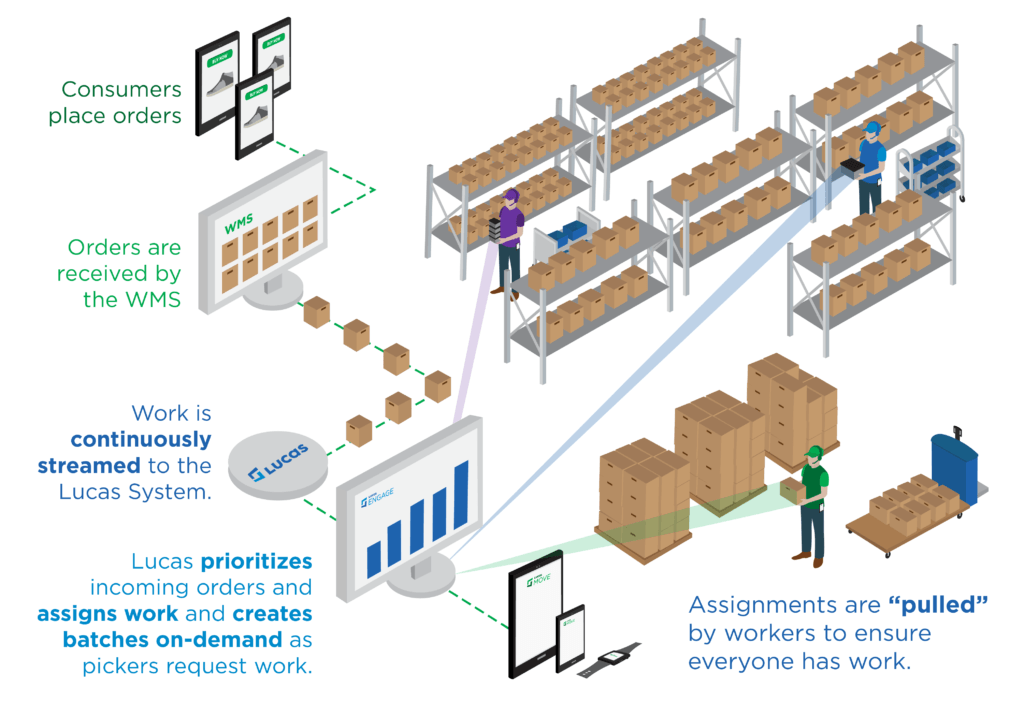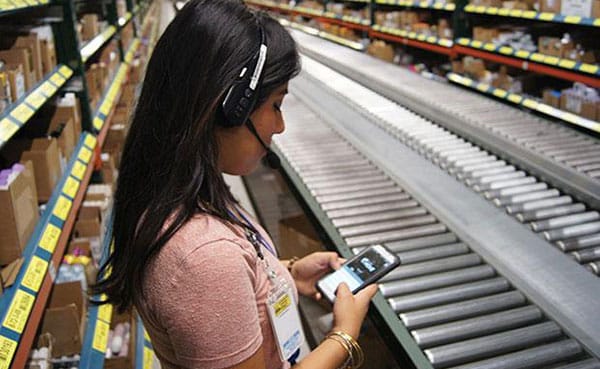Waveless picking (also sometimes referred to as order streaming) is a method used by warehouses and distribution centers to continuously release customer orders for fulfillment. It is an essential capability for consumer goods manufacturers, wholesalers, and retailers that need to ship growing volumes of ecommerce orders.
The term waveless picking is used as a contrast to wave picking, which is the traditional method for processing large wholesale or store replenishment orders. Many DCs struggle to adapt to rising ecommerce order volumes alongside wholesale orders because their ERP and warehouse management systems (WMS) only support wave-based picking.
This is a growing challenge for distribution centers that are experiencing an unexpected increase in ecommerce orders. Warehouse optimization solutions lets DCs implement waveless picking with a legacy WMS or ERP. This ensures DC can efficiently ship ecommerce orders alongside wholesale and other B2B orders.
What is Wave Picking?
Wave picking is a common method of creating discrete groupings of orders (waves) that are released in sequence (wave 1 followed by wave 2, etc.) for picking throughout a shift or work day. It is an efficient way for DCs to organize and process large business-to-business orders and to manage DC throughput. Each wave of work typically represents one or more hours’ worth of work for picking, packing and shipping, based on the capacity constraints of the DC (for example, the number of loading doors, sorter capacity, etc.). Waving is a standard capability in most warehouse management systems.
Waves can be created in a WMS (or other software system) based on pre-defined rules, or managers can manually create waves in the system. The objective is to achieve a desired volume and flow of work based on order volume, truck departures, replenishment schedules, available labor, material handling equipment capacity, and other factors. A WMS may allocate inventory based on the waves. In some cases the system will generate replenishment tasks to ensure sufficient inventory is available to fill the orders.
Waves Define Picking Sequences
In many cases, waves of work are created at the start of a shift or work day based on all available orders at the time. In addition to creating the waves, many WMS systems will also break down each wave into discrete picking assignments. For example, the WMS may apply rules to define which products and orders will be picked on every pallet, in every tote, and every cart throughout the day.
In traditional wave-based picking, waves are released and processed in sequence, and once a wave is released it cannot be changed. In some facilities, the first wave must be completed before the next one can be released. This leads to an uneven distribution of work throughout a facility, meaning some workers will be waiting for work (or “stacking” work for future waves in their work area), while workers in other zones complete the current wave. In many DCs, however, multiple waves can be in process for picking at the same time – reducing the problem of uneven work distribution. Workers in one area may start picking a second wave before a first wave is fully completed in other picking zones.
Given the Covid-19 induced surge in ecommerce, many DCs that ship B2B orders are now facing unexpected volumes of direct-to-consumer orders that have shorter delivery time-frames. Filling these direct-to-consumer orders in a traditional wave-based picking system brings a new set of challenges.
Ecommerce Fulfillment Requires Waveless Picking
Ecommerce orders need to be turned around quickly, often the same day they are placed or even within a one to four hour window to meet next day or two-day delivery requirements. Wave picking systems are not designed to manage a constant flow of incoming orders with super short shipping deadlines.
Companies that cannot ship ecommerce orders quickly risk losing sales. A survey conducted by Digital Commerce 360/Bizrate Insights found that 44% of consumers in the U.S do not complete an online order if it will not arrive when they want it. Traditional DC operations need to adapt their current picking, packing and shipping processes to respond to the challenge of fulfilling a rising volume of ecommerce orders.
As noted above, in traditional wave-based picking, waves are often created at the start of a shift and released in sequence. Once released, the first waves are picked prior to subsequent waves, and the waves cannot be changed once they are released. As a result, an ecommerce order received at 2 pm cannot be added to an in-process wave.
At best, this incoming ecommerce order could be added to the next wave that has not yet been released. In practice, this 2pm order might be released in a wave at 2:15, but it will still sit behind orders in previous waves. Those prior waves could represent several hours worth of work. Even worse, some wave-based picking systems cannot adjust a wave plan that has already been completed. In those cases, any orders received today would have to be added to the next day’s waving plan and schedule.
Waveless picking eliminates the constraints of “waves” and works well for any operation that needs to handle a continuous stream of incoming orders with short delivery timeframes.
Waveless Picking with Warehouse Optimization Solutions
In a waveless picking approach, incoming orders are made available for picking as they are received. The order pool is continually updated, so that an order received at 2 pm can be released for picking almost immediately. This creates other challenges that many wave-based WMS systems may not be able to handle.
In particular, waveless systems require dynamic rules for prioritizing orders, sequencing work, and creating optimized picking assignments across zones in a facility. DCs supporting multiple channels need to ensure that wholesale orders are picked, packed and shipped complete and on time using rules similar to those in their wave-based system, while simultaneously processing ecommerce orders based on other rules.
Within the Lucas system, Jennifer™ addresses this challenge by applying prioritization rules to suit ecommerce and traditional wholesale orders. First, as orders are received, Jennifer™ assigns a priority code based on ship time, delivery date, customer or order type, and other variables that can be tailored for each DC. As workers request their next picking assignment, Jennifer™ will give the worker the highest priority order available in his picking zone, or create an optimized batch of work based on order priorities and batching schedules.

Waveless Order Picking Enables Workers To “Pull” Available Work
With a waveless picking approach, orders are “pulled” as workers are available, rather than being pushed in waves. Managers can change the priority of orders and make other adjustments throughout a shift or work day to balance workflow or labor.
The Benefits of Waveless Picking Include:
- Shorter Turnaround Times. Since incoming orders are prioritized and made available for picking immediately, rush orders can be picked, packed, and shipped within hours of receipt. Next-day and two-day orders are out the door on time and in the hands of the consumers on promised delivery dates.
- Increased Productivity. The waveless approach eliminates slack time as one wave completes and the next is released. Workers receive a steady stream of work and are not waiting around for the next wave to drop.
- Increased Throughput. Improved productivity and steady work release and distribution increases throughput and results in more efficient allocation of workers and equipment.
The Future Of Fulfillment
Ecommerce has been growing steadily since the 1990s, but Covid-19 has accelerated the ecommerce transition in many industries. This is forcing traditional business-to-business DCs that had seen small volumes of ecom orders to adapt and improve turnaround times for online orders.
Waveless picking allows DC’s to efficiently process the constant influx of quick-turnaround, small direct-to-consumer orders without impacting their ability to serve core B2B customers.






